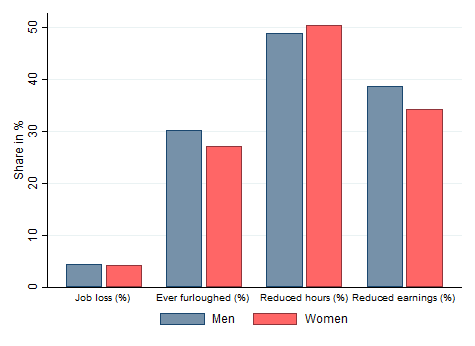Claudia Hupkau (CUNEF Madrid) and Barbara Petrongolo (Queen Mary University London) discuss what the likely implications of a second lockdown are for gender equality at work and in the home.
The start of a second lockdown in the UK is raising many questions about its impact on the economy and society more broadly, as well as about its implications for gender equality in the workplace and at home. To counter negative effects on employment, the government has announced that it will reinstate the original furlough scheme into spring 2021. The self-employed will also receive support, although less generous than the first time around.
Jobs during lockdowns
Analysing UK data from Understanding Society, a longitudinal household survey, Figure 1 shows that during the first lockdown (April-May 2020), men and women were equally likely to lose their jobs, and men were slightly more likely to have been put on furlough. While the share of women with lower working hours was higher than the share of men, the overall reduction in hours worked was smaller for women than for men, on average. Women were slightly less likely to have experienced a reduction in earnings, and if they did, their earnings losses were smaller than those experienced by men.
Figure 1: Labour market impact of COVID-19 by gender
 Source: ‘Work, care and gender during the COVID-19 crisis‘.
Source: ‘Work, care and gender during the COVID-19 crisis‘.
The new measures, set to last until 2 December, include the closure of non-essential retail, gyms, hairdressers and restaurants, restrictions to social interactions in homes and a ban on all non-work-related travel. In contrast to the first lockdown, manufacturing businesses and construction sites will remain open. According to HMRC data, by the end of July 2020, a total of 1.8 million people had been furloughed in the manufacturing and construction sectors (Figure 2), both dominated by male employees (representing about 74% and 87% of employment in those industries, respectively).

While, during the earlier stages of the pandemic men tended to be slightly more likely to be on furlough, by 31 August, 1.63 million women remained on furlough, compared to 1.5 million men. Adding to this slower exit out of furlough, sectors with a large share of female employment will be subject to a second lockdown. In the accommodation and food services sector, for instance, 53% of jobs are held by women. This is likely to raise the probability of job loss or being put on furlough for women relative to men this time around. Whether these potentially unequal labour market impacts will have longer-term consequences for gender equality will depend on how long the new measures last, whether the affected sectors will return to normal in the near future or whether there will be structural changes in the hospitality and tourism industry, for instance.
Figure 2: Coronavirus Job Retention Scheme claims (furlough) by sector, as of 31 July 2020
 Source: HMRC, Coronavirus Job Retention Scheme (CJRS) Statistics: August 2020
Source: HMRC, Coronavirus Job Retention Scheme (CJRS) Statistics: August 2020
Childcare needs
The second, major difference between this lockdown and the first is that nurseries, schools, and universities are set to remain open. During the first lockdown, parents had to meet the entirety of the increased childcare and home-schooling needs. In two-parent households, total time spent on childcare and home-schooling rose from nearly 25 hours a week at baseline to more than 41 hours during April and May 2020. According to data from the UK Time Use Survey, in 2014-15 mothers were doing, on average, 17 hours of childcare, while fathers were doing just under eight hours. During April and May 2020, mothers’ hours rose to 26.5, and fathers’ hours rose to 14.8. Women took on board a higher share of the increased childcare needs than men (9.5 extra hours as opposed to 6.9 extra hours), with a corresponding increase in the gender gap from 9.2 hours in 2014-15 to 11.7 hours in April and May 2020. Looking at the month-to-month evolution of the contribution of mothers and fathers in couple households to childcare and home-schooling, shown in Figure 3, we can appreciate an increase in the gender gap in June, when the UK eased out of the first lockdown but schools and nurseries remained closed. Fathers’ contribution to childcare dropped by nearly five hours from May to June, from 14 hours to 9.2 hours, while mothers’ contribution fell by only two hours.
The fact that schools will remain open this time around, will lessen the additional burden of childcare and home-schooling for parents overall. But the combination of potentially higher furloughing among women with a higher average contribution of women to childcare needs, both at baseline and during the first lockdown, might further reinforce gender roles in families where the mother remains or becomes the main childcare provider during this period.
Figure 3: Weekly hours spent on childcare and home-schooling by gender since the onset of the pandemic
 Source: Authors’ analysis of Waves 1-4 of Understanding Society, Covid-19 study.
Source: Authors’ analysis of Waves 1-4 of Understanding Society, Covid-19 study.
While the best part of the additional childcare load has, on average, been taken over by mothers – largely according to pre-existing specialisation patterns of spouses – the share of households in which the father was the main childcare provider has risen by nearly eight times, from 2.7% in 2016-17 to about 18% in April and May 2020 (Figure 4). Being out of work, be it due to lay-offs or being put on furlough, has nudged many fathers into taking over a much bigger share of childcare, potentially causing a long-term shift in gender roles in the affected households.
Figure 4: Main provider of childcare in couple households with kids aged 15 and below

Source: Adapted from Claudia Hupkau & Barbara Petrongolo, “Work, care and gender during the COVID-19 crisis”, Covid Economics, Issue 54, October 2020.
The outlook for the second lockdown
While overall we have seen a rise in the gender gap in childcare and home-schooling, the first lockdown provoked a radical change in the organisation of work and family life, which may produce long-lasting, positive consequences via learning, habit formation, and the evolution of social norms. A higher incidence of working from home is likely to positively affect worker productivity and work-life balance. In the medium term, we might observe a reversal of traditional gender roles in a sizeable share of UK households, in which fathers took the role of primary childcare providers during the first lockdown. However, in other households, particularly where mothers will be forced to stay home again during the second lockdown while fathers can continue to work, traditional gender roles might be further entrenched.
This post represents the views of the authors and not those of the COVID-19 blog, nor LSE. It first appeared at LSE British Politics and Policy.





